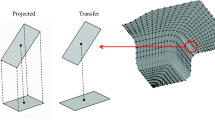Abstract
In this paper, we revisit the plane strain deep-drawing process. We show that a detailed analysis of the physical process may result in a dramatic reduction of computing time when the problem is split into several regions undergoing well-defined loading paths. The proposed approach allows us to assess the springback of the formed sheet in a quasi-instant time and is thus suitable in the initial design phase and provides a fast and economical way to determine the influence of the numerous parameters involved in sheet metal forming. We present a semi-analytical model that has been developed for sheet metal forming mainly subjected to plane strain bending-under-tension and involving large strains. The sheet is considered to be an assembly of regions where the loading is considered homogeneous in the length direction. A handful of finite elements or even a single element is sufficient to compute the loading path followed by each region. The contact is circumvented by constraining the kinematics with appropriate boundary conditions and the approach is valid for any material behavior law. The semi-analytical model is applied to standard test cases and then compared with full-scale simulations.


















Similar content being viewed by others
References
Alexandrov S, Hwang YM (2009) The bending moment and springback in pure bending of anisotropic sheets. Int J Solids Struct 46:4361–4368
Alexandrov S, Manabe K, Furushima T (2011) A general analytic solution for plane strain bending under tension for strain-hardening material at large strains. Arch Appl Mech 81:1935–1952
Asnafi N (2000) Springback and fracture in v-die air bending of thick stainless steel sheets. Mater Des 21:217–236
Breitkopf P, Naceur H, Rassineux A, Villon P (2005) Moving least squares response surface approximation: formulation and metal forming applications. Comput Struct 83:1411–1428
Brem JC, Barlat F, Fridy JM (2002) Free bending benchmark testing of 6111-T4 aluminium alloy sample. In: Numisheet Conference, Korea
Bruhns OT, Gupta NK, Meyers ATM, Xia H (2003) Bending of an elastoplastic strip with isotropic and kinematic hardening. Appl Mech 72:759–778
Buranathiti T, Cao J (2004) An effective analytical model for springback prediction in straight flanging processes. Int J Mater Prod Technol 21:137–153
Code_Aster (2009) Analysis of structures and thermomechanics for studies & research. EDF–R&D
Da Silva Botelho T, Bayraktar E, Inglebert G (2006) Comparison of experimental and simulation results of 2D-draw-bend springback. J Achiev Mater Manuf Eng 18:275–278
Duncan J, Shabel B, Filho J (1978) A tensile strip test for evaluating friction in sheet metal forming. Tech. rep., SAE Technical Paper 780391
Hallquist JO (2006) LS-DYNA theory manual. Livermore Software Technology Corporation
Hill R (1950) The mathematical theory of plasticity. Clarendon Press, Oxford
Konter AWA (2005) Advanced finite element contact benchmarks. Tech. Rep., FENET
Lee MG, Kim D, Wagoner RH, Chung K (2007) Semi-analytic hybrid method to predict springback in the 2D draw bend test. J Appl Mech 74:1264–1275
Makinouchi A, Nakamachi E, Onate E, Wagoner RH (1993) Guide to the benchmark test—simulation and experiment. Numisheet’93 conference, The Institute of Physical and Chemical Research, pp 32–39
Naceur H, Delaméziere A, Batoz JL, Guo YQ, Knopf-Lenoir C (2004) Some improvements on the optimum process design in deep drawing using the inverse approach. J Mater Process Technol 146:250–262
Parsa M, Nasher Al Ahkami S (2008) Bending of work hardening sheet metals subjected to tension. Int J Mater Form 1:173–176
Pourboghrat F, Chung K, Richmond O (1998) A hybrid membrane/shell method for rapid estimation of springback in anisotropic sheet metals. J Appl Mech 65:671–684
Sun G, Li G, Zhou S, Xu W, Yang X, Li Q (2011) Multi-fidelity optimization for sheet metal forming process. Struct Multidiscip Optim 44:111–124
Zhang D, Cui Z, Ruan X, Li Y (2007) An analytical model for predicting springback and side wall curl of sheet after u-bending. Comput Mater Sci 38:707–715
Zhu HX (2007) Large deformation pure bending of an elastic plastic power-law-hardening wide plate: analysis and application. Int J Mech Sci 49:500–514
Acknowledgments
This research was conducted as part of the OASIS project, supported by OSEO within the contract FUI no.F1012003Z.
The authors acknowledge the support of Labex MS2T.
Author information
Authors and Affiliations
Corresponding author
Rights and permissions
About this article
Cite this article
Le Quilliec, G., Breitkopf, P., Roelandt, JM. et al. Semi-analytical approach for plane strain sheet metal forming using a bending-under-tension numerical model. Int J Mater Form 7, 221–232 (2014). https://doi.org/10.1007/s12289-012-1122-7
Received:
Accepted:
Published:
Issue Date:
DOI: https://doi.org/10.1007/s12289-012-1122-7




